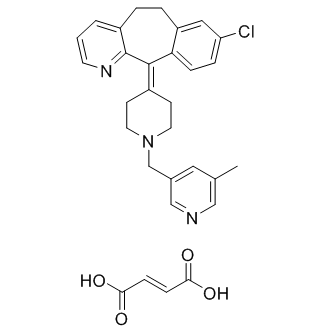| Cas No.: | 182349-12-8 |
| Chemical Name: | Rupatadine Fumarate |
| Synonyms: | Rupatadine Fumarate; Rupafin; Alergoliber; Rinialer; Pafinur; Rupax; Ralif |
| SMILES: | CC1=CN=CC(CN2CC/C(CC2)=C3C4=CC=C(Cl)C=C4CCC5=CC=CN=C5\3)=C1.O=C(O)/C=C/C(O)=O |
| Formula: | C30H30ClN3O4 |
| M.Wt: | 532.04 |
| Sotrage: | 2 years -20°C Powder, 2 weeks 4°C in DMSO, 6 months -80°C in DMSO |
| Description: | Rupatadine Fumarate (UR-12592 Fumarate) is a potent dual PAF/H1 antagonist with Ki of 0.55/0.1 uM(rabbit platelet membranes/guinea pig cerebellum membranes). |
| In Vivo: | Rupatadine blocked histamine- and PAF-induced effects in vivo, such as hypotension in rats (ID50 = 1.4 and 0.44 mg/kg i.v., respectively) and bronchoconstriction in guinea pigs (ID50 = 113 and 9.6 micrograms/kg i.v.). Moreover, it potently inhibited PAF-induced mortality in mice (ID50 = 0.31 and 3.0 mg/kg i.v. and p.o., respectively) and endotoxin-induced mortality in mice and rats (ID50 = 1.6 and 0.66 mg/kg i.v.) [1]. rupatadine treatment improved the declined lung function and significantly decreased animal death. Moreover, rupatadine was able not only to attenuate silica-induced silicosis but also to produce a superior therapeutic efficacy compared to pirfenidone, histamine H1 antagonist loratadine, or PAF antagonist CV-3988 [3]. |
| In Vitro: | Rupatadine competitively inhibited histamine-induced guinea pig ileum contraction (pA2 = 9.29 +/- 0.06) without affecting contraction induced by ACh, serotonin or leukotriene D4 (LTD4). It also competitively inhibited PAF-induced platelet aggregation in washed rabbit platelets (WRP) (pA2 = 6.68 +/- 0.08) and in human platelet-rich plasma (HPRP) (IC50 = 0.68 microM), while not affecting ADP- or arachidonic acid-induced platelet aggregation [1]. The IC50 for rupatadine in A23187, concanavalin A and anti-IgE induced histamine release was 0.7+/-0.4 microM, 3.2+/-0.7 microM and 1.5+/-0.4 microM, respectively whereas for loratadine the IC50 was 2.1+/-0.9 microM, 4.0+/-1.3 M and 1.7+/-0.5 microM. SR-27417A exhibited no inhibitory effect [2]. |

 DC Chemicals' products qualify for U.S. tariff exemptions. We guarantee no price increases due to customs duties and maintain stable supply, continuing to deliver reliable research solutions to our American clients.
DC Chemicals' products qualify for U.S. tariff exemptions. We guarantee no price increases due to customs duties and maintain stable supply, continuing to deliver reliable research solutions to our American clients.





















